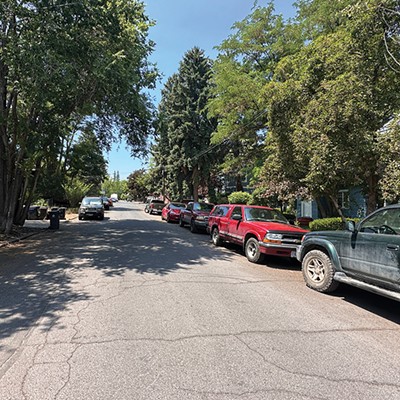Thanks to Bend’s meteoric population growth over the past decade, House District 54, aka the Bend House seat, will be carved up before Democrats have a chance to gain a firm hold on the seat that was established during the last round of legislative redistricting in 2001. Based on the most recent census numbers, legislators will have to carve off roughly 18,000 residents from House District 54 to meet statewide population targets for legislative districts.
Just how to shrink the population of Bend’s House district is a matter of significant local contention with statewide implications. Currently, the 60-member Oregon House of Representatives is evenly split at 30-30, thanks to significant gains by Republicans in the 2010 midterm election. Those gains included Jason Conger’s defeat of Democratic incumbent Judy Stiegler, who helped the Democrats wrestle control of the seat from Republicans in 2006 when she defeated Republican legislator Chuck Burley.
As is the case with most states, the job of redrawing Oregon’s political lines falls to the legislature where it becomes a deeply partisan affair wherein the two parties typically craft widely disparate proposals for new boundaries and then wrangle to an impasse before the job passes to the secretary of state’s office or the courts.
“I’ve been on the record and I’ll say again, redistricting is the most political thing we do as legislators,” said Rep. Gene Whisnant, a Sunriver Republican whose district, which includes all of Deschutes County outside of Bend, was carved up by his own party leaders in the GOP proposal.
The plan—which is unlikely to gain much traction, given that Democrats control the state senate and the governor’s office—put Whisnant in a sprawling rural district that stretches from Chiloquin to Prineville. It also placed him in the awkward position of having to criticize his own party’s political blueprint.
“Obviously, for convenience and because I’ve spent the last eight years representing the people of Redmond and Deschutes County, the Democrat’s plan is better for me, but it’s not about me, it’s about what’s best for everyone,” Whisnant said.
The Donut Hole
The majority of focus, however, isn’t on Deschutes County, but on Bend, which is one of the few places east of the Cascades where Democrats maintain a slight voter registration advantage over Republicans. It’s one of the reasons that local Republican politicians have complained about the current House district map since it was adopted in 2001 after an unsuccessful legal challenge by Republicans. For a decade now, conservatives have referred disparagingly to Bend’s House district as “the Donut,” a circle of Democratic blue in a Republican sea of red. While there is a legal rationale for lumping Bend’s residents together, a standard that prohibits lawmakers, and the courts for that matter, from dividing “communities of like interest” along political lines, many observers agree it’s a nebulous standard.
“A community of interest is in the eye of the beholder,” said Bill Lunch, an Oregon State University political science professor who serves as a political analyst for Oregon Public Broadcasting.
“In Bend, for example, the age of eastside housing stock is different than the western stock. You could make an argument on the other hand that Bend is a city and that Bend as a whole is a community of interest,” Lunch said.
Understandably, Republicans have been spoiling for a chance to carve up Bend along more favorable lines, even as the party demonstrated that it could win in the current alignment, which Republicans have long alleged was loaded for Dems, taking two of the last three elections. Not surprisingly, the map put forward by the state GOP reflects that desire. The proposal carves the entire northeast side of Bend into a newly aligned House district that stretches from Sunriver to Powell Butte and includes Redmond, the second largest city in the tri-county area.
The remainder of Bend, in addition to Deschutes River Woods, would be recategorized as House District 53. According to the data compiled by the Oregon Republican Party that plan would maintain a slight edge in voter registration for Democrats, while peeling off some of the more conservative leaning eastside precincts into the newly drawn House District 54, which would include most of Deschutes County and a portion of Crook County. The plan, which varies significantly from the Democratic proposal and the current alignment has, of course, drawn fire from Democrats who oppose the idea of dividing Bend. Mayor Pro-tem Jodie Barram testified at the hearing in Bend and said she’s opposed to any plan that breaks the core area of Bend into two legislative districts.
“Bend is a very diverse place and to try to dilute that is not in the best interest of Bend,” Barram said. “It seems like what you’re seeing is the partisanship coming out.”
Barram, a Democrat, said she didn’t have any contact with the local party before or after the meeting and that her comments weren’t politically driven. Rather, she said her primary interest is keeping services like the Bend Area Transit and existing political boundaries like the Central Area Plan, the city’s ongoing revitalization project for the area east of downtown along the 3rd Street corridor, in the same legislative district.
“Regardless of whether it’s the Democratic or Republican plan, it’s what’s in the best interest of Bend. And for me, that’s Option 1,” said Barram, referring to the Democrat’s plan.
A History of Failure
Even the parties, however, have had trouble agreeing on their own maps, as Whisnant’s disenfranchisement demonstrates. Last week, Oregon Democrats reversed course on their proposal, offering a second map that addressed criticisms of their initial map, some of which came from within their own party. The latest proposal didn’t affect Bend and the map preserves most of the city’s pre-boom core, from the Mt. Washington Drive corridor on the westside to 27th Street on the eastside, while shaving off many of the northside neighborhoods as well as the more rural Deschutes River Woods.
Sen. Chris Telfer serves as a co-chair on the Senate redistricting committee and is a former Bend city councilor. She helped to referee a public hearing in Bend on the redistricting issues and said she believes the GOP’s plan for Bend more closely reflects the testimony that was received by her committee. It’s an issue that Secretary of State Kate Brown would also examine if the redistricting issue reaches her desk. Telfer said she doesn’t see what unique populations the state would be protecting by drawing lines around city programs like Bend Area Transit or the Central Area Plan, as Barram advocates. Rather, she said the committee heard that the more clear divisions exist along geographic lines.
“I think what we heard is that east Bend is a lot different than west Bend and that the north is a lot different than the south,” Telfer said.
In addition, Telfer said the Republican map simply acknowledges the existing strong ties between Bend and Redmond, and perhaps surprisingly to some, Powell Butte, by placing at least portions of all three areas within a legislative district, while keeping the rest of Bend in a single House district.
But just what shape the final boundaries will take is open for debate. The legislature has until the end of June to adopt a plan. History is not on its side. Over the past 40 years, the two parties have been either unable to craft a plan, or the legislature drew a map that was later overturned by the courts. Still, there are signs that a deal could be coming in the next few weeks.
Telfer emphasized that the maps are simply a starting point for negotiations that will begin in earnest next week between Democrats and Republicans. Because the governor has already pledged to sign any bipartisan redistricting bill, there is additional pressure on legislators to get a deal done.
“We’re trying to show a number of things and one is pride. We’re trying to show the naysayers that we can do this, and we’re trying to shed some of our partisanship,” Telfer said.
“Frankly if we can’t do a bipartisan map with the structure we have and the lay of the land, it can’t be done,” she said.
Telfer isn’t the only one touting the prospect of a deal. Democrats have indicated that they’re willing to take a run at a legislative solution. That’s important because it could be the legislature’s last kick at the redistricting can. Former gubernatorial candidate and conservative activist Kevin Mannix attempted to craft a measure that would have cut the legislature out of the process entirely by turning the job over to a non-partisan commission, as some other state’s have already done. Mannix announced this spring that he is already collecting signatures to send the question to voters next year.
The news has perhaps provided extra incentive for both sides to get a deal finished.
“All signs indicate that we are working toward a compromise,” said one Democratic Party insider who asked not to be identified. “It’s one of the most political things we do. But we’re trying to do it in good faith.”
The same source said that while Democrats expect that they could get a favorable proposal from Secretary of State Kate Brown, a Democrat, the party would rather leave nothing to chance. Either way, she said the party is committed to keeping Bend competitive for Democratic candidates.
“I think (Bend) is taken very seriously. There’s a big progressive community and a strong Democratic Party. All the pieces are there,” the source said.
Longtime Democratic organizer and strategist Stacey Dycus agrees. As long as the final map doesn’t deviate too far from the Democratic Party’s proposal, she believes that Bend can remain competitive even as the local House district diverges from Bend’s urban boundary line.
“What I tell potential candidates is that they should still consider [running]. The district just gets better and better,” Dycus said.
A Short History of Legislative Districting
Every 10 years, the legislature is required to modify the boundaries of the state’s legislative districts based on the latest census data. If the legislature is unsuccessful, the burden falls to the secretary of state’s office. The following is a look at how the redistricting responsibilities have shaken out over the past half-century.
1951 – Legislature fails to adopt a plan
1961– Legislature adopts a new map that is signed by the Governor. Courts overturn the plan. Matter is referred to the secretary of state
1971 – No plan from the Legislature. Secretary of State draws new map
1981 – Plan adopted by Legislature is overturned by the courts. Secretary of state draws new map.
1991 – No plan adopted by the legislature. Secretary of state puts forward plan that is adopted after a court challenge and minor modification.
2001 — Governor vetoes legislature’s proposal. Secretary of State develops new map with court-required modifications.
Source: State of Oregon Legislative Administration.






















